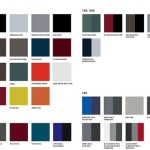How To Choose The Right Paint Color For Your Living Room Walls
Selecting the ideal paint color for living room walls is a pivotal decision in interior design, significantly impacting the atmosphere and appeal of the space. The living room often serves as a central gathering place, a space for relaxation, and a reflection of personal style. Therefore, a thoughtful approach to paint color selection is essential to achieve the desired aesthetic and functional goals.
Numerous factors influence the perception of color, including natural and artificial light, existing furniture, architectural details, and personal preferences. Navigating these variables requires a systematic evaluation of the space and a comprehensive understanding of color theory. This article provides guidance on how to choose the right paint color, ensuring a harmonious and inviting living room environment.
Understanding the Impact of Color on Mood and Perception
Color psychology plays a significant role in how individuals perceive and react to a space. Different colors evoke distinct emotions and associations, influencing the overall mood of the living room. A thorough understanding of these psychological effects is crucial in making an informed decision.
Warm colors, such as reds, oranges, and yellows, tend to create a sense of energy, warmth, and comfort. These colors can be stimulating and inviting, making them suitable for spaces intended for socialization and activity. However, the intensity of warm colors should be carefully considered, as overly saturated tones can be overwhelming in larger spaces. Muted or earthy warm tones often provide a more balanced and calming effect.
Cool colors, including blues, greens, and purples, are generally associated with tranquility, serenity, and relaxation. These colors can create a calming and spacious atmosphere, making them ideal for living rooms where relaxation and unwinding are prioritized. Lighter shades of cool colors can enhance the feeling of openness and airiness, while darker shades can add depth and sophistication.
Neutral colors, such as whites, grays, beiges, and browns, offer versatility and can be used as a foundational element in any living room design. Neutrals provide a backdrop that allows other elements, such as furniture, artwork, and accessories, to take center stage. They also offer a sense of timelessness and can be easily adapted to changing trends. The undertones of neutral colors should be carefully considered to ensure they complement the existing elements in the room. For instance, a gray with warm undertones may pair well with warm-toned wood furniture, while a gray with cool undertones may complement silver or chrome accents.
Evaluating the Living Room's Existing Conditions
Before selecting a paint color, a thorough assessment of the living room's existing conditions is imperative. Factors such as natural light, artificial lighting, existing furniture, flooring, and architectural features all contribute to how a paint color will appear in the space. Failing to consider these elements can result in a color choice that clashes with the overall aesthetic or fails to achieve the desired effect.
Natural light is a critical factor in determining how a paint color will appear. Rooms with ample natural light tend to be more forgiving, allowing for a wider range of color choices. However, it's important to note that the direction of sunlight can affect the color's appearance. South-facing rooms tend to have warm, bright light, which can enhance warm colors and neutralize cool colors. North-facing rooms receive cooler, less intense light, which can make cool colors appear even cooler and warm colors appear muted.
Artificial lighting also plays a significant role in color perception. Different types of light bulbs emit different color temperatures, which can alter the appearance of paint colors. Incandescent bulbs produce a warm, yellowish light, while fluorescent bulbs emit a cooler, bluish light. LED bulbs offer a range of color temperatures, allowing for greater control over the lighting environment. It is recommended to test paint samples under the intended lighting conditions to ensure the color is as expected.
Existing furniture, flooring, and architectural features should also be taken into account when selecting a paint color. The paint color should complement the existing elements in the room, creating a cohesive and harmonious aesthetic. For instance, if the living room features warm-toned wood furniture, a paint color with warm undertones may be a suitable choice. Similarly, if the flooring is a cool-toned gray, a paint color with cool undertones may be more appropriate. Architectural details, such as crown molding, wainscoting, and fireplaces, can also influence the choice of paint color. These features can be highlighted with contrasting colors or integrated seamlessly with the wall color.
Practical Steps for Selecting and Testing Paint Colors
The process of selecting and testing paint colors involves several practical steps to ensure the final choice is both aesthetically pleasing and functional. Starting with color inspiration, narrowing down the options, obtaining samples, and testing those samples under different lighting conditions is essential for a successful outcome.
Begin by gathering inspiration from various sources, such as magazines, websites, and design books. Identify colors and styles that resonate with personal preferences and align with the desired mood and atmosphere of the living room. Create a mood board or a digital collection of images that showcase the desired aesthetic. This visual aid can help to narrow down the color palette and provide a clear direction for the selection process.
Once inspiration is gathered, narrow down the color options to a manageable number. Consider the factors discussed earlier, such as the room's existing conditions, the impact of color on mood, and the desired style. Select a few different shades of the same color or a combination of complementary colors. Obtain paint samples of the chosen colors from a local paint store. Most paint stores offer small sample sizes, which are ideal for testing purposes.
Testing paint samples is a crucial step in the selection process. Apply the samples to a large area of the wall, ideally in multiple locations, to observe how the color appears under different lighting conditions. Observe the samples throughout the day, noting how the color changes with the natural light. Also, observe the samples under artificial lighting, both during the day and at night. Evaluate how the colors interact with the existing furniture, flooring, and architectural features in the room. Allow the samples to dry completely before making a final decision, as the color may change slightly as it dries. If unsure, live with the samples for a few days to ensure satisfaction with the chosen color.
Consider using paint visualizer tools, which many paint companies offer on their websites. These tools allow uploading a photo of the living room and virtually "painting" the walls with different colors. While these tools are helpful for visualizing the overall effect, they should not be relied upon solely for color selection, as the colors displayed on a computer screen may not accurately represent the actual paint color. Always test physical paint samples on the wall before making a final decision.
Finally, consult with a professional interior designer or color consultant for expert guidance. These professionals have the knowledge and experience to assist in selecting the right paint color based on the specific needs and preferences. They can also provide valuable insights into color trends, color combinations, and the overall design aesthetic of the living room.
By carefully considering the psychological impact of color, evaluating the room's existing conditions, and following a systematic approach to selecting and testing paint colors, individuals can create a living room that is both aesthetically pleasing and functionally suitable for their needs.

Dulux Living Room Paint Colours

Bright Paint Color Ideas To Consider Forbes Home

10 Wall Colour Paint Ideas To Make Your Living Room More Pleasant

55 Best Living Room Paint Colors From Designers

Dulux Living Room Paint Colours

Choosing The Right Paint Colors For Your Living Room

Best Paint Colour For Walls Home Interior Ideas Livspace

50 Best Living Room Paint Ideas Colors

Dulux Living Room Paint Colours

55 Best Living Room Paint Colors From Designers
Related Posts








